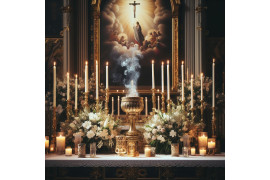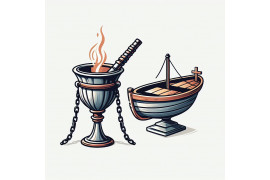The history of altars and chimes traces back to ancient times in the Guinea Coast region, where indigenous tribes used altars, chimes, and gongs in religious ceremonies at churches. Made from materials like bronze and iron, these bells, also known as chimes or gongs, played a significant role in spiritual practices and rituals in churches. They were often used to create a sacred atmosphere and were placed on altars. Their joyful noise filled churches, as the sanctus bells rang out during the Eucharist, signifying the presence of the Lord. Altar bells were not only symbolic but also practical, serving as a way to gather the congregation in churches and create a sacred atmosphere during the sanctus and Eucharist. From Easter celebrations to daily Masses, these sanctus bells added a touch of solemnity and blessing to worship services, drowning out the noise and creating an atmosphere reminiscent of a sacred museum. This blog post delves into the fascinating origins and significance of altar bells in the art of the sanctus. The met Lord has a deep connection to these bells throughout history.
Purpose and Placement of Altar Bells in the Sanctuary
Altar bells, also known as sanctus bells, have a specific purpose and are strategically placed within the sanctuary area of a church. These bells are a part of the art collection in the church and are used to signal the presence of the Lord during worship. Sanctus bells, also known as small bells, play an important role during Mass, signaling significant moments in the liturgy. These outdoor tower bells are not to be confused with the dinner bell. Let's explore their purpose and placement further.
Purpose: Signaling Important Moments
The primary purpose of altar bells is to signal important moments during the celebration of the Sanctus, a sacred art in which the Lord is praised. When you hear sanctus bells or outdoor tower bells, it signifies a sacred moment or artful action taking place in the presence of the Lord. These moments include:
-
Sanctus: The ringing of the altar bell during the Sanctus (Holy, Holy, Holy) part of the Eucharistic Prayer indicates the consecration of bread and wine into the Body and Blood of Christ. It serves as a reminder for worshipers to focus their attention on this sacred moment, with the sound of the sanctus bells ringing through the air. Additionally, the dinner bell signals the start of the meal, bringing everyone together to enjoy their food.
-
Elevation: Another significant moment signaled by altar bells is during the elevation of the consecrated Host and Chalice after the consecration of the sanctus. This is when Catholics believe that Jesus becomes truly present in these elements, such as the sanctus bells and dinner bell.
-
Communion: Altar bells may also be rung at various points during the distribution of Holy Communion, marking each communicant's reception of the sanctus.
Placement: Convenient Access for Priests
Altar bells, also known as sanctus bells, are typically positioned near the altar or on a side table within easy reach for priests during Mass. This strategic placement allows priests to ring the sanctus bells without interrupting or moving away from their designated spot at the altar. Additionally, they can also use the dinner bell for a different purpose during mealtime.
The most common placement locations for altar bells include:
-
On or near the credence table: The credence table is usually located to one side of the sanctuary area where liturgical items such as cruets, chalices, patens, and sanctus bells are prepared before Mass. Sanctus altar bells can be conveniently placed here for easy access by priests when needed.
-
On a small stand near the altar, some churches have sanctus stands specifically designed to hold altar bells. These sanctus stands are often placed near the altar, ensuring that the sanctus bells are within reach but not obtrusive.
-
Hanging on a wall near the sanctuary area of certain churches, altar bells may be hung to signify the sanctus. This placement allows priests to easily ring the sanctus bells by pulling a cord or using a small handle.
The specific placement of altar bells and the sanctus may vary from church to church, depending on architectural considerations and personal preferences of the clergy.
Role of Altar Bells in the Catholic Church Mass
During the Catholic Mass, altar bells play a significant role as auditory cues, guiding worshipers through different parts of the ceremony, including the sanctus. The ringing of these bells serves to mark key moments and add solemnity to sacred actions, especially during the sanctus.
Auditory Cues for Transitions
Altar bells are rung at specific points in the Mass to signify transitions and draw attention to important events, such as the sanctus. One such moment is during the consecration and elevation of the Eucharist, where the sanctus bells ring to signify the transformation of the bread and wine into the body and blood of Christ. The ringing of altar bells at this point helps to emphasize the significance of the sanctus and invite reverence from those present.
Adding Solemnity and Reverence
The sound of altar bells carries a sense of sanctus, sacredness, and reverence throughout the Mass. As worshipers participate in various prayers, readings, and rituals, the gentle chime of the sanctus bells creates an atmosphere that encourages focus and contemplation. The sound of the sanctus bells during Mass reminds individuals of the holiness of the act and calls them to give their full attention to each part of the Mass.
Guiding Worshiper's Focus
The use of altar bells also helps guide worshipers' focus during different sections of the Mass. For example, when transitioning from one part to another, such as from the Liturgy of Word to the Liturgy of Eucharist, ringing the bells alerts attendees that there is a change occurring. This auditory cue, known as sanctus bells, assists in maintaining engagement by signaling that it is time for them to shift their attention or prepare for what comes next.
In addition to marking transitions within the Mass itself, altar bells can also serve as reminders for individuals who may be engaged in private prayer or contemplation during certain parts of the ceremony. The sound of the sanctus bells acts as a gentle reminder that something significant is happening within the liturgy, drawing their attention back towards communal worship.
By incorporating auditory cues through bell ringing, altar bells play a crucial role in enhancing the overall experience of the Catholic Mass. Sanctus bells create an atmosphere of reverence, guide worshipers' focus, and add solemnity to sacred actions. Through the sound of the sanctus bells, they remind individuals of the significance of each moment within the liturgy.
Tradition and Technique: Ringing the Altar Bell
Ringing the sanctus bells at the altar in the Catholic Church is a time-honored tradition that adds a touch of reverence and significance to various moments during Mass. Priests employ specific techniques to ensure that the sound produced by the sanctus bells is clear, resonant, and harmonious with other elements of worship.
A gentle swing or tap is all it takes to create that distinct ringing sound of the sanctus bells. This technique allows the sanctus bells to produce a melodic tone without overpowering other prayers or hymns being sung. The goal is to strike a balance between drawing attention to important moments in the liturgy while still maintaining an atmosphere of solemnity. One way to achieve this is by incorporating the use of sanctus bells.
In some churches, there are designated servers who have the responsibility of ringing the sanctus bells at appropriate times during Mass. These individuals are trained in the proper technique and timing required for the task of ringing the sanctus bells. The sanctus bells play a crucial role in the ritual, ensuring consistency and maintaining its sacredness.
The tradition of ringing altar bells has been passed down through generations within the Catholic Church. It dates back centuries and holds deep symbolic meaning. The sound of the sanctus bells serves as a call to worship, inviting congregants to focus their attention on key moments throughout Mass.
One such moment when altar bells are rung is during consecration—the part of Mass where bread and wine are transformed into the body and blood of Christ, according to Catholic belief. As the celebrant utters the words of consecration, signaling this miraculous transformation, an altar server rings the sanctus bells, underscoring its significance.
Altar bells also play a role during communion, specifically when communicants approach to receive Holy Communion. The ringing of the sanctus bells serves as a reminder that this sacrament represents Christ's presence among his followers.
Altar bells may be rung during certain parts of Eucharistic prayer or other significant moments in liturgical celebrations such as processions or adoration services dedicated to honoring Jesus in his blessed sacrament.
The ringing of the sanctus bells is not only a tradition but also an important practice within the Catholic Church. Sanctus bells serve as a way to enhance the worship experience, drawing attention to key moments in the Mass and fostering a deeper sense of reverence and awe. The sound of the sanctus bells echoes through the sanctuary, reminding all present of the sacredness of the holy sacrifice being celebrated.
Exploring Church Bells: Origin and Significance
Church bells have a rich history dating back centuries across different cultures worldwide. Originally used as timekeepers, they evolved into symbols with diverse meanings. Church bells became an integral part of Christian worship, signaling important events like services or emergencies. Their significance extends beyond religion, serving as community markers and sources of cultural identity.
Rich History Dating Back Centuries
The history of church bells spans across civilizations and continents. From ancient Rome to medieval Europe to present-day societies, the ringing of bells has held immense importance. In ancient times, bells were primarily used as timekeeping devices, alerting communities to the passage of time throughout the day. Over time, their purpose expanded to include various other functions.
Evolution from Timekeepers to Symbols
As society progressed, church bells began to take on symbolic meanings beyond their practical use for timekeeping. They became powerful symbols within religious contexts and acquired spiritual significance. The sound of church bells resonated with worshipers and conveyed messages that went beyond mere announcements.
Integral Part of Christian Worship
In Christianity, church bells hold a special place in worship practices. They are rung during specific moments in religious ceremonies and events such as weddings, funerals, and regular services. The sound of the bell serves as a call to prayer and a reminder for believers to gather for communal worship.
Signaling Important Events
One significant role that church bells play is signaling important events within the community or congregation. For example, they announce the beginning or end of religious services or mark significant moments during these gatherings. In times of emergency or crisis, church bells can be used to alert people in the surrounding area about potential dangers or urgent situations.
Community Markers and Cultural Identity
Beyond their religious significance, church bells also serve as community markers and sources of cultural identity. The distinct sound of a local bell can evoke feelings of nostalgia among community members and create a sense of belonging. In some towns and villages, the sound of church bells can be heard at specific times throughout the day, becoming a familiar and comforting presence.
The Symbolism and Cultural Impact of Church Bells
Church bells have a rich history and hold significant symbolism in religious and cultural contexts. They serve as a powerful reminder of the presence of God and play an essential role in calling the faithful to prayer. These bells are associated with joyous occasions such as weddings and holidays, bringing communities together in celebration.
The unique sound of church bells resonates through the air, reaching every corner of a town or village. This distinctive chime has a profound impact on communities, fostering a sense of unity and tradition among its members. The ringing of church bells signals important events and serves as a call to worship, inviting congregations to gather for religious services.
Throughout history, church bells have inspired various forms of art, literature, and music. Artists have depicted bell towers in paintings and sculptures, capturing their grandeur and significance within the architectural landscape. Writers have often used the melodic sound of bells as metaphors for spiritual awakening or moments of reflection. Composers have incorporated bell sounds into musical compositions to evoke emotions ranging from reverence to jubilation.
The use of church bells extends beyond their symbolic meaning; they also provide practical functions within communities. In earlier times, when clocks were scarce or unreliable, tower bells served as timekeepers for residents. Their rhythmic tolling marked the passage of hours throughout the day, helping people organize their daily activities.
Moreover, church bells historically played an important role in communicating urgent messages or warnings to the community. For instance, during times of war or natural disasters, specific bell patterns would alert villagers about impending danger or call them to take shelter.
In modern times, technology has allowed for more precise control over bell ringing mechanisms. Automated systems can produce complex melodies by combining different pitches and rhythms seamlessly. This advancement has further enhanced the artistic potential that church bells offer while ensuring consistent quality in their performance.
The cultural impact of church bells cannot be understated. They are an integral part of religious ceremonies, community celebrations, and even everyday life in some places. The sound of bells ringing can evoke a sense of nostalgia and familiarity, connecting individuals to their heritage and traditions.
Unveiling the Fascinating History of Altar Bells
The history of altar bells is a captivating journey that spans across ancient civilizations and various cultures. These small bells have played significant roles in religious practices, particularly in Christianity during the medieval period. Today, their historical significance continues to captivate scholars and enthusiasts alike.
Ancient Origins and Cultural Significance
Altar bells can be traced back to ancient times, when different cultures incorporated bells into their religious rituals. In many ancient civilizations, such as those in Egypt, Greece, and Rome, bells were seen as sacred objects with mystical powers. They were believed to ward off evil spirits and bring blessings upon the worshipers.
Varied Purposes in Different Cultures
Different cultures utilized altar bells for various purposes. In some traditions, the ringing of sanctus bells during the Mass signified moments of great reverence and awe. The sound of these outdoor tower bells echoed through the air, alerting people to gather for worship or indicating important moments within the liturgy.
Rise to Prominence in Christianity
During the medieval period, altar bells gained prominence within Christian worship. These small bells were placed on altars and used during Mass to signify important moments, such as the consecration of bread and wine into the body and blood of Christ. The ringing of altar bells added a sense of joyous celebration and reverence to these sacred rituals.
Symbolism and Spiritual Significance
Altar bells hold deep symbolism within Christian traditions. Their melodious chimes are believed to represent joyful noise offered up to God during worship. The ringing also serves as a reminder of miracles associated with faith – from Moses using silver trumpets to part the Red Sea to angels announcing Jesus' birth.
Preserving History in Museums
Throughout history, many precious altar bells have been crafted with intricate designs and artistic details. Some have even been made from precious metals like silver or gold. Today, these historical artifacts can be found in museums, showcasing the craftsmanship and religious devotion of the past.
Continuing Legacy and Modern Use
While altar bells may not be as prevalent in modern worship practices, they still hold a special place in certain Christian denominations. The ringing of bells during specific parts of the Mass, such as the elevations or the consecration of the Precious Blood, continues to enhance the spiritual experience for worshipers.
Altar Bells in the Catholic Church: Their Role at Mass
We have learned that these bells play a vital role during Mass, serving to draw attention to important moments and events within the liturgy. Placed on or near the altar, they are rung by the priest or an acolyte to signal key transitions, such as the consecration of the Eucharist or the arrival of Christ's presence.
Understanding the history and symbolism behind altar bells enhances our appreciation for their use in worship. These bells have been an integral part of Catholic tradition for centuries, with origins dating back to early Christian practices. By ringing them with precision and reverence, Catholics honor their rich heritage and create a sensory experience that engages both sight and sound.
To delve deeper into this fascinating topic, continue reading our upcoming sections where we will explore church bell origins and significance, as well as unveil more about the captivating history of altar bells.
FAQs
What materials are altar bells typically made from?
Altar bells can be made from various materials such as brass, silver, or even wood. The choice of material often depends on personal preference or traditional customs within specific religious communities.
Are there any rules regarding when to ring altar bells during Mass?
While there are no strict universal rules governing when exactly to ring altar bells during Mass, certain moments are commonly accompanied by their sound. These may include the elevation of the Host and Chalice during consecration or when receiving Communion.
Can anyone ring an altar bell?
Typically, it is either a priest or an acolyte who rings an altar bell during Mass. This responsibility is usually entrusted to individuals who have received proper training in liturgical practices.
Are there different types of altar bells used in different parts of the world?
Yes, there can be variations in the design and style of altar bells used in different regions. Cultural and historical factors often influence these differences, making each set of bells unique to its respective tradition.
Can altar bells be used outside the Catholic Church?
While altar bells are most commonly associated with the Catholic Church, they can also be found in other Christian denominations or religious practices where similar traditions are observed. Their use may vary depending on specific liturgical customs.



